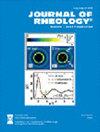一个完全生理信息的时间和速率依赖的血液流变学本构模型
IF 3.2
2区 工程技术
Q2 MECHANICS
引用次数: 1
摘要
从力学的角度来看,血液是一种复杂的流体,对所施加的变形具有速率和时间依赖性的反应。在小变形率下,由于纤维蛋白原蛋白的桥接,细胞聚集导致rouleaux结构的形成,表现为血液粘度的总粘度的大幅增加和可测量的屈服应力的出现。在高变形率下,这些内部聚集的细观结构以动态方式分解,产生血液的热运动记忆和触变行为。血液的这些丰富而复杂的流变学特征主要由不同细胞之间的相互作用以及红细胞(RBCs)的比例决定。在这里,使用一系列详细的计算工具和基准实验测量,我们提出了一个本构模型,该模型基于血液的两个生理指标:红细胞压积和纤维蛋白原浓度,准确描述了血液的速率和时间依赖性流变学。我们表明,该模型能够准确预测血流,不仅在简单的稳定流动下,而且在与真实循环系统相关的不同流动方案下。本文章由计算机程序翻译,如有差异,请以英文原文为准。
A fully physiologically-informed time- and rate-dependent hemorheological constitutive model
From a mechanical perspective, blood is a complex fluid with a rate- and time-dependent response to an applied deformation. At small deformation rates, cell aggregations owing to the bridging of fibrinogen proteins result in the formation of rouleaux structures manifesting in a large increase in the overall viscosity of the blood viscosity and the emergence of measurable yield stress. At elevated deformation rates, these internal aggregated mesostructures are broken down in a dynamical fashion, giving rise to a thermokinematic memory and thixotropic behavior of the blood. These rich and complex rheological features of blood are primarily governed by the interactions between different cells as well as the fraction of red blood cells (RBCs). Here, using a series of detailed computational tools and benchmarking experimental measurements, we present a constitutive model that accurately describes the rate- and time-dependent rheology of blood based on two physiological metrics of the blood: the hematocrit and fibrinogen concentration. We show that the model is capable of accurately predicting blood flow, not only under simple steady flows but also under different flow protocols relevant to a real circulatory system.
求助全文
通过发布文献求助,成功后即可免费获取论文全文。
去求助
来源期刊

Journal of Rheology
物理-力学
CiteScore
6.60
自引率
12.10%
发文量
100
审稿时长
1 months
期刊介绍:
The Journal of Rheology, formerly the Transactions of The Society of Rheology, is published six times per year by The Society of Rheology, a member society of the American Institute of Physics, through AIP Publishing. It provides in-depth interdisciplinary coverage of theoretical and experimental issues drawn from industry and academia. The Journal of Rheology is published for professionals and students in chemistry, physics, engineering, material science, and mathematics.
 求助内容:
求助内容: 应助结果提醒方式:
应助结果提醒方式:


